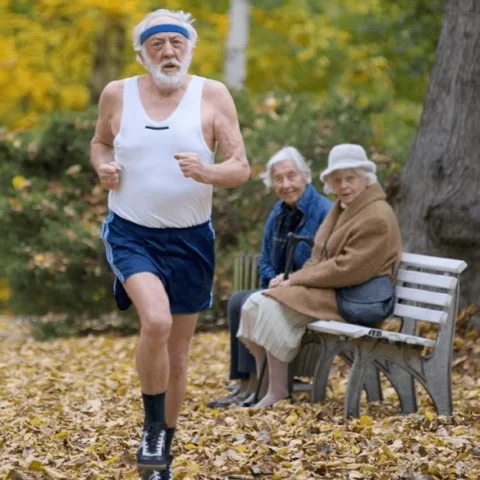
Some time ago, I came across a concept created by Dr. Peter Attia, MD, a wellness and longevity physician, called the Centenarian Olympics. This concept involves thinking of what you want to do when you are 100 years old, and then working backwards from there to figure out what you should be capable of doing today. This does not mean that you have to actually compete in the Centenarian Olympics, or even do anything that involves athletics. However, the concept is that if you want to be able to even just carry out basic, everyday tasks that you take for granted now, you must have a plan. If you do work out in a structured manner on a regular basis, it gives you some guidance and motivation for what you should be doing, and why you are doing it. In fact, I write this at the top of my exercise tracking notebook each time I start a new page.
Even if you have no desire to actually live to be 100 years old, this will set you up to be a fit and functional 80 year old.
An example of how this concept works is try to think of 3-5 things that you want to be able to do when you are 100 years old.
For instance, if you want to be able to bend down and lift your four year old grandchild who might way 40 pounds, you probably need to establish your current goal of being able to properly execute a 150 pound deadlift. This is because overtime, even with a rigorous workout plan, you are going to lose some amount of strength and function. So, at 50 years of age, you might shoot for double to triple the weight you would be shooting for at 80 or 100.
Another example is that if you want to be able to lift a 40 pound carry-on bag into an overhead bin on an airplane without assistance at age 80, you should simulate that action with an overhead press of 80-100 pounds, using both hands. However, since that can be rough on the shoulders, one way to modify this exercise is to lower the weight, but increase the amount of repetitions. For instance, you could shoot for 50 pounds for 5-10 repetitions. You could even simulate this action more realistically with an actual suitcase or carry-on bag that you could load up with bags of sand, or even your best vacation clothes so that it is already packed for your next trip!
Those are two strength based activities, but we must not neglect the ability to move in general. This ability typically declines significantly with aging. My movement goal is to be able to get up from the floor only using one hand for support at the age of 80. That means currently, I need to be able to get up from the floor, with ease and fluidity, without the use of any hands whatsoever.
Endurance and stamina also become a limiting factor with age for most people, so you should probably establish a goal in that area. My goal is to be able to hike a Colorado 14er with an eight pound pack on my back at the age of 80. So, at this point, my goal is to be able to hike five miles with 25 pounds on my back without experiencing any significant fatigue or soreness after.
How many specific goals you would like to have is completely up to you, but I would suggest to keep it relatively simple. Just think of basic upper and lower body strength, basic movement patterns and endurance.
I hope this article will inspire you to maintain goals that will allow you to live your best life now, stay motivated during your workouts, and ultimately make you that fit and functional 100 year old that you can be!
Sources
Image from: https://benchmarkphysio.com.au/what-exercises-should-older-adults-do/
